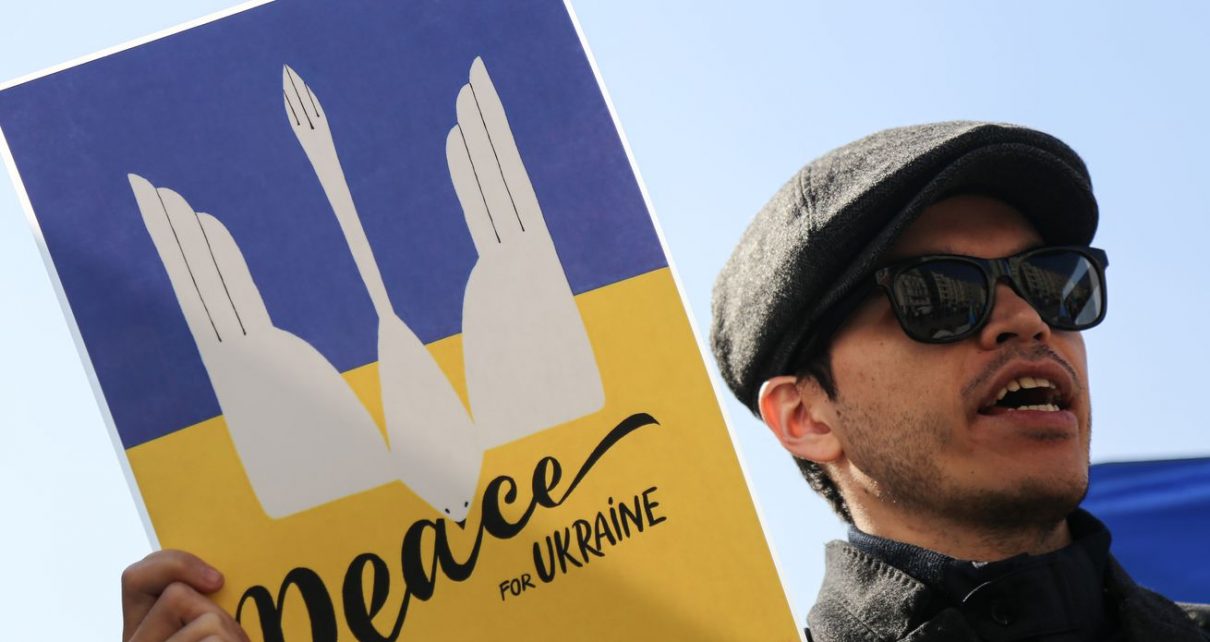
Why Ukraine staying out of NATO is emerging as a possible settlement to end the war.
Even as the war in Ukraine rages, officials from Ukraine and Russia are in negotiations to find a way to end the conflict. And neutrality is one of the key principles Kyiv and Moscow are reportedly negotiating right now.
The idea of Ukraine serving as a neutral bridge between Russia and the West is not new. But one month into a war in which Ukrainian resistance has scuttled Russia’s larger war aims, the idea has regained cache as a solution to help stop the devastation in Ukraine — and to guard against future conflict.
In broad terms, Ukrainian neutrality would likely force it to abandon its ambitions of ever joining the North Atlantic Treaty Organization (NATO) and forgo hosting any NATO installations on its territory, likely in exchange for some sort of security guarantees, to prevent Russia from launching another invasion.
Both Ukraine and Russia may find something palatable in it. Ukrainian President Volodymyr Zelenskyy has acknowledged that Ukraine will not actually join NATO, and Ukrainian officials have indicated they’re open to discussing Ukraine’s status. It may also be something Russia could accept, if keeping NATO out of Ukraine, and away from Russia’s borders, is an outcome Russian President Vladimir Putin could spin at home. Kremlin spokesperson Dmitry Peskov has said that a deal for a neutral Ukraine could be a “kind of compromise.”
Ukrainian neutrality, said Pascal Lottaz, assistant professor for neutrality studies at the Waseda Institute for Advanced Study, may be the only option “where all the parties — the Russians, the Ukrainians, and the US and NATO — would basically sit down and say, ‘Fine, we can accept that; fine, we can live with that.’”
But it will depend on the details. Ukraine formally abandoned its neutral status in 2014, after Russia annexed Crimea and invaded Eastern Ukraine. Putin’s grievances ahead of the war went far beyond Ukraine’s possible — but also extremely unlikely — NATO membership, and so Russia may have a different version of neutrality in mind. Indeed, Putin’s other stated goal of “demilitarization” of Ukraine hints at that.
“Neutrality — that term is used here, but it’s not really what any of this is about,” said Mark Kramer, director of the Cold War Studies Project at the Davis Center for Russian and Eurasian Studies at Harvard University. “It’s about complete subservience, and I think that’s what Ukrainians have thoroughly rejected.”
Russia, in attacking Ukraine, trampled over its own international agreements and obligations, which is going to make neutrality — or potentially any brokered deal — require more than Putin’s signature. Some combination of the world’s powerful countries is likely going to have to get involved, including possibly the United States, Europe, NATO, even China. These countries may have to decide how far they are willing to go to assure Ukraine’s neutrality, if it comes to that. And if NATO, say, becomes a guarantor of Ukraine’s neutral status, suddenly Ukraine doesn’t seem so neutral after all.
A neutral Ukraine, then, might sound fine to everyone. But neutrality only works because countries see it in their political and security interests to respect that status — and, as bombs continue to fall, it is not yet clear Russia sees it that way, too.
What might a neutral Ukraine look like? Let’s look around the neighborhood.
Europe is no stranger to neutral states, whether in 19th century Europe or during the Cold War. As Ulrika Möller, associate professor in political science at the University of Gothenburg said, neutrality is an instrument for smaller states to protect their own political integrity against a major neighbor or regional power. As she put it: “We want to stay alive, so what do we have to do to stay alive?”
Maartje Abbenhuis, a war historian at the University of Auckland, said that often the thing we call neutrality is actually “neutralization,” where “the world agrees to remove something out of the foreign policy, so everybody agrees not to attack it.”
A version of “neutralization” is likely in store for Ukraine. Although Kyiv may agree to adopt a policy of neutrality, if it sticks, it will be because Ukraine, Russia, and the West see it in their interest to preserve that status. Russia would agree to respect Ukraine’s territorial integrity, but that also likely means NATO’s open door to Ukrainian membership would close.
Ukraine would have some company in Europe among neutral, or non-aligned states. Austria, Finland, Sweden, Ireland, and Malta are all neutral or nonaligned countries within the European Union. Switzerland, famously, is neutral, though not in the EU.
All those countries have militaries since they still have the right to defend themselves if someone violates that neutrality. Some, like Switzerland and Sweden, have embraced a version of neutrality for centuries. Others adopted it out of both outside pressure and necessity, like Finland, which shares an 800-mile border with Russia. Russia invaded Finland in 1939, and though the Finns fended off a Russian takeover, in the interest of not having that happen again, it signed a friendship treaty with Russia in 1948, and stayed non-aligned during the Cold War, though it put up with a lot of Soviet meddling and influence through that period.
Peskov, the Kremlin spokesperson, reportedly suggested that both sides were talking about the possibility of an Austrian or Swedish-like neutrality for Ukraine. And experts said Austria may be the best analogue for a future neutral Ukraine.
After World War II, the Allied powers (France, Britain, the US, and the Soviet Union) occupied Austria, much like Germany. In exchange for ending the occupation, Austria agreed to declare neutrality. On October 26, 1955 — the day after the deadline for the last foreign troops to leave Austria — Austria adopted permanent neutrality into its constitution. Austria wouldn’t join military alliances, wouldn’t take sides in future wars, and wouldn’t allow foreign bases on their territory.
Over time, neutrality becomes intertwined with a country’s political identity, regardless of whether it was imposed or a choice. Austria’s neutrality was the bargain to end occupation. Peter Ruggenthaler, deputy director of the Ludwig Boltzmann Institute for Research on the Consequences of War, noted that Austrian political parties have generally been wary of supporting NATO membership, and most Austrians oppose it, too. “It is less for the population a question of security — it is mostly a question of identity,” he said.
That doesn’t mean external factors can’t shift a country’s nonaligned position — or that neutrality itself can’t be a bit flexible. Public support for joining NATO has crept up in Sweden and Finland in the wake of Russia’s invasion, though not by overwhelming margins. And though both remain formally nonaligned, both cooperate quite closely with NATO already.
Still, neutrality is a valuable geopolitical instrument that a non-aligned state can wield to advance its own interests. It’s also the reason why European security questions were hashed out in Helsinki during the Cold War, and why Vienna is host to the Iran deal negotiations today.
Neutrality for Ukraine would also seem to be the ideal political instrument: a former Soviet Republic that could become a buffer between Russia and the rest of Europe, managing ties with both. That’s why the idea of neutral Ukraine wasn’t born out of this war. But agreeing to that status now, amid one, is even more complicated.
The complicated questions around Ukrainian neutrality
Russia continues to bombard cities and destroy civilian infrastructure like hospitals and a theater. More than 1,000 Ukrainian civilians have been confirmed killed as of March 25 (a number likely much higher that will continue to rise) and more than 10 million people have been displaced, with more than 3.7 million of them fleeing to other countries. The Russian army has seen astounding casualties, too, with NATO saying possibly as many as 15,000 Russian soldiers have been killed so far. Meanwhile, Western sanctions are strangling Russia’s economy, leaving ordinary Russians to suffer.
The costs multiply each day the war goes on. The best hope for a ceasefire, and a longer-term truce, may be an agreement on Ukraine’s neutral status.
Ukraine committed to neutrality in the aftermath of the breakup of the Soviet Union; each of its swings away from neutrality was usually in response to Russian threats or aggression. Russia does have valid security concerns about NATO being on its borders. But Putin’s rhetoric has denied Ukrainian statehood and demanded the “demilitarization and denazification of Ukraine,” a false attack that is largely code for regime change.
Putin’s maximalist position doesn’t really square with just accepting neutrality — although battlefield losses and Ukraine’s resistance may have changed Moscow’s calculus. But even so, that leads to another problem: Who trusts Putin now?
“There were probably at least a dozen international agreements that Russia signed with Ukraine that did commit Russia to respecting Ukraine’s December 1991 borders, yet, the Russian government has shown no importance to adhering to those obligations,” said Kramer, of Harvard’s Davis Center.
An agreement between Ukraine and Russia on neutrality won’t be sufficient. Vlad Mykhnenko, an economic geographer at the University of Oxford who has written about the conflict in Eastern Ukraine, said even if there is a treaty, little is stopping Russia from breaking it. “What happens then, if [Putin] says: ‘Oh, actually, we don’t like it. I’m going in, there is something we don’t like in Ukraine, and we have to clear it out.’”
That may be the biggest question about Ukraine’s neutral status: Who is going to guarantee it stays that way?
That is where the rest of the world comes in, likely the US and its allies. And a lot depends on what risks they are willing to tolerate — and whether that would be acceptable to Ukraine or Russia.
Mykhnenko said that if a neutral Ukraine was again attacked, there should be a “guarantee to provide military help, and boots on the ground.”
The obvious candidates to back Ukraine are those that have the most at stake: Europe, the US, and NATO. But some suggested it might take more than that, and countries like China might need to get involved to help enforce and sweeten the deal for Russia.
How strong these guarantees are matters. If they involve NATO allies committing to backing Ukraine up in case Russia goes full-scale invasion again, that would be a lot like NATO membership in all but name. “Would the United States or other NATO countries be allowed to use military force if an agreement in the family is violated? That, I think, may be a bridge too far for the Russians at this point,” said P. Terrence Hopmann, a professor of international relations at Johns Hopkins University.
But, Hopmann added, given the bad faith Putin has shown in negotiations, it will be difficult for Ukraine to accept neutrality without some serious security guarantees. Other experts said non-military mechanisms, like automatic sanctions or other penalties, are an option. But it seems unlikely those would be sufficient for a country that is pleading with the West for a no-fly zone.
“That’s the circle that’s hard to square in this case,” Hopmann said. “That’s where we’re stuck right now, in many ways.”
Neutrality, but then what?
If Russia does accept Ukrainian neutrality, it will likely be because Putin’s quick victory plan has floundered. But in Ukraine, where the vast majority of the public wants to fight, and believes they will win, neutral status feels much more loaded than it might have a month ago.
“It’s much harder now for Ukrainians to accept this under the pressure of the Russian military threat and a war going on in [their] country,” Hopmann said. “It looks like now they’re doing it under the barrel of a gun, rather than as the voluntary wishes of the Ukrainian population.”
Ukrainians under siege are also deeply skeptical that neutrality is what Russia wants. “Russia will not honor any security guarantees because Russia will accept nothing less than Ukraine’s destruction,” said Mychailo Wynnyckyj, a sociologist from the National University of Kyiv-Mohyla Academy. “It’s not about status, it’s about existence.”
Those who see a neutral Ukraine as the only solution to end the war are seeing this more multipolar world through a realist lens. There are big powers in competition, and there are weaker powers who get caught in the middle, and they are likely to be forced into choices for their survival, whether or not they fit with ideas of democracy and freedom and self-determination.
Neutrality may solve one dilemma, but any negotiated deal between Russia and Ukraine will almost certainly address issues beyond neutrality. Some of the demands Russia has reportedly put forward include the so-called “demilitarization” and “denazification” of Ukraine. Denazification is fake, and likely an effort at regime change — something that Ukrainians, who have rallied around Zelenskyy’s leadership, will not agree to right now.
Exactly what demilitarization means is also unclear, but experts said it could mean limits on Ukraine’s offensive weapons or troop numbers. But the idea that Ukraine would give up its military after just being invaded seems unfathomable, and, again, most neutral countries maintain armies.
And of course there are the questions of Ukraine’s territory, and whether Moscow will demand the recognition of Russian control of Crimea and/or try to carve out the Donbas, where Russia has declared two regions independent, and where it appears to be escalating its offensive.
But these discussions are happening amid a war that is making it hard for either side to engage in diplomacy, as they’re still trying to win concessions by other means. Turkey’s foreign minister, Mevlut Cavusoglu, who is helping to broker the talks, said recently that while there is momentum, “it’s not that easy to negotiate while the war is ongoing or to agree when civilians are dying.”
“The outcome of the war will be decided on the battlefield,” Mykhnenko said. “I’m afraid that’s a basic truth. Whatever discussion, decisions, debates, negotiations are taking place in Belarus or Istanbul — all of that is just a sideshow.”
But all wars, whether fought to a draw or with a clear victor, end in agreements. The only difference is how much suffering and destruction happens in the process of getting there. Advocates for Ukrainian neutrality believe the sooner that happens, the sooner it will spare Ukraine, and the rest of Europe, from more tragedy.
“In the end,” said Lottaz, the professor for neutrality studies, “it will be a Ukrainian model, it will be unique — if it becomes something. But again, it’s either neutrality or Afghanistan. At least I don’t see another way out.”





